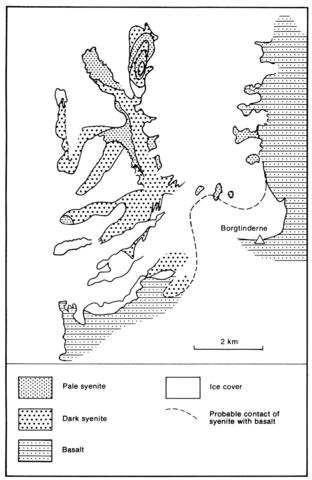stripes
The Borgtinderne complex is one of a number of intrusions within the Tertiary basalt terrain east of Kangerdlugssuaq. The outcrop area is approximately 10x8 km but much of the complex is buried by ice and snow fields. Contacts with Tertiary tholeiitic basalts are sharp and dip outwards at 70° in the south but at less than 30° in the east. There are numerous basalt xenoliths within the complex and the erosion level appears to be close to the original roof. Leucocratic and mesocratic varieties of nepheline syenite with gradational boundaries between them can be distinguished, the latter considered by Brown et al. (1978) to be the product of assimilation of basalts. The leucocratic nepheline syenite consists of up to 90% perthite, interstitial or euhedral nepheline, sodalite, aegirine-augite, aegirine, amphibole and minor biotite, apatite, magnetite and sphene with pyrochlore in some varieties. The mesocratic syenites vary from rocks with partly assimilated basalt xenoliths to homogeneous amphibole-rich syenites. Mafic varieties contain areas of augite surrounded by zones of brown amphibole, while the more homogeneous rocks contain brown, subhedral amphibole grains frequently with partly replaced pyroxene cores. Plagioclase is zoned, sometimes to perthite rims, and alkali feldspar is more abundant in leucocratic varieties; sodalite, sometimes with nepheline, is interstitial. Hornfelsing and metasomatism of large basalt rafts are readily apparent.
BROWN, P.E., BROWN, R.D., CHAMBERS, A.D. and SOPER, N.J. 1978. Fractionation and assimilation in the Borgtinderne syenite. Contributions to Mineralogy and Petrology, 67: 25-34.
GLEADOW, A.J.W. and BROOKS, C.K. 1979. Fission track dating, thermal histories and tectonics of igneous intrusions in East Greenland. Contributions to Mineralogy and Petrology, 71: 45-60.

